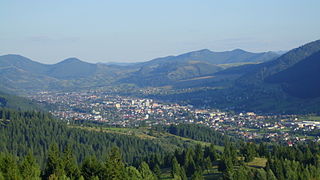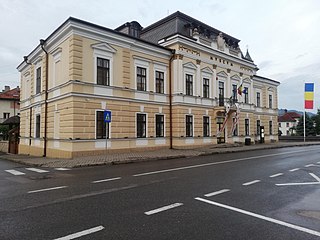Related Research Articles
The 41 județe and the municipality of Bucharest comprise the official administrative divisions of Romania. They also represent the European Union' s NUTS-3 geocode statistical subdivision scheme of Romania.

Bukovina is a historical region, variously described as part of either Central or Eastern Europe. The region is located on the northern slopes of the central Eastern Carpathians and the adjoining plains, today divided between Romania and Ukraine.

Suceava County is a county of Romania. Most of its territory lies in the southern part of the historical region of Bukovina, while the remainder forms part of Western Moldavia proper.

Vatra Dornei is a town in Suceava County, north-eastern Romania. It is situated in the historical region of Bukovina. Vatra Dornei is the fifth largest urban settlement in the county, with a population of 14,429 inhabitants, according to the 2011 census.

Câmpulung Moldovenesc is a city in Suceava County, northeastern Romania. It is situated in the historical region of Bukovina.
Vasile Hutopila is a contemporary Romanian painter of Ukrainian ethnicity. His works belong to impressionism.

Ținutul Suceava was one of the ten Romanian administrative regions (ținuturi) created on August 14, 1938, as a part of King Carol II's administrative reform. From August 14, 1938, to June 28, 1940, it included the whole of Bukovina, a county of Bessarabia (Hotin) and a county of Moldavia (Dorohoi). It was named after the river Suceava. Its administrative capital was the city of Cernăuți. After its northern part was ceded to the USSR on June 28, 1940, Ținutul Suceava was restructured on September 16, 1940, when Baia county became a part of the region, and abolished only a few days latter, on September 22, 1940. Ținutul Suceava had two governors: Gheorghe Alexianu and Gheorghe Flondor. Alexianu's mandate was marked by the suppression of ethnic minority and Jewish rights.

The Bukovina Germans, also known and referred to as Buchenland Germans, or Bukovinian Germans, are a German ethnic group which settled in Bukovina, a historical region situated at the crossroads of Central and Eastern Europe, during the modern period. They are part of the larger group of Romanian Germans since the early 20th century, when they were initially living in the Kingdom of Romania.

Gheorghe Flondor was Romanian politician who served as Royal Resident of Ținutul Suceava from February 7, 1939 to September 23, 1940.
This article discusses the administrative divisions of the Kingdom of Romania between 1941 and 1944. As a result of the Soviet occupation of Bessarabia and Northern Bukovina, Second Vienna Award and the Treaty of Craiova, territories that had previously been part of Romania were lost to the Soviet Union, Hungary and Bulgaria respectively. By September 1940 the administrative system set up in 1938 based on 'ținuturi' (regions) was disbanded and the former counties (județe) were reintroduced.
Vasile Grecu was an Austro-Hungarian-born Romanian philologist and Byzantinist.

Teodor V. Ștefanelli was an Imperial Austrian-born Romanian historian, poet, prose writer and lawyer.

Câmpulung County is one of the historic counties of the Kingdom of Romania, in the historical region of Bukovina. The county seat was Câmpulung Moldovenesc.

The Therapeutic Baths’ Casino of Vatra Dornei, also known as the Vatra Dornei Casino, is an abandoned historic monument located in Suceava County, Romania in the town of Vatra Dornei. It was built in 1898 by Austrian architect Peter Paul Brang while the territory was part of the Austro-Hungarian Empire. It is located on the Dorna River.

Suceava Region was an administrative-territorial division located in the northeastern part of the Romanian People's Republic, established in 1950, when the counties were abolished. It existed until 1968, when the regions were abolished.

The Bukovina Governorate was an administrative unit of Romania during World War II.
Iorgu G. Toma was an Austro-Hungarian-born Romanian journalist, translator and politician.
Epaminonda Bucevschi was an ethnic Romanian painter from the Duchy of Bukovina in Austria-Hungary.
Zorile Bucovinei is a Romanian-language newspaper published in Chernivtsi, Ukraine. It is one of the oldest Romanian publications in Chernivtsi Oblast.
References
- ↑ Hitchins, Keith (2014). A concise history of Romania. Cambridge University Press. pp. 1–327. doi:10.1017/CBO9781139033954. ISBN 9780521872386.
- ↑ Șandru, Florin (2013). "Political and cultural evolution of the Romanians in the Romanian ancestral territories of Bessarabia and Bukovina over the course of time". Bulletin of "Carol I" National Defense University. 2 (1): 46–65.
- 1 2 "Ziua Bucovinei". Agerpres (in Romanian). 25 November 2016. Archived from the original on 16 February 2017.
- ↑ Coman, Dan (28 November 2018). "Ziua Bucovinei a fost recunoscută prin lege în urma unei inițiative a deputatului ALDE Alexandru Băișanu". Monitorul de Suceava (in Romanian).
- ↑ Bărăgoiu, Luigi (27 November 2019). "Manifestări de Ziua Bucovinei și de Ziua Națională a României, la Rădăuți". Monitorul de Suceava (in Romanian).
- ↑ "Manifestările care vor avea loc astăzi în Suceava, de Ziua Bucovinei". Obiectiv de Suceava (in Romanian). 28 November 2019.
- ↑ "100 de ani de la unirea Bucovinei cu România". Știrile TVR (in Romanian). 29 November 2018.
- ↑ "Ziua Bucovinei la Putna". RădăuțiZiar (in Romanian). 29 November 2018.
- ↑ "Mănăstirea Putna sărbătorește Ziua Bucovinei". Suceava News Online (in Romanian). 27 November 2018.
- ↑ Bighiu, Doru (7 January 2016). "Spectacol extraordinar de Ziua Bucovinei la Vatra Dornei". Monitorul de Dorna (in Romanian).
- ↑ ""Ziua Bucovinei" sărbătorită și la Câmpulung Moldovenesc". Suceava News Online (in Romanian). 26 November 2017.
- ↑ Ignătescu, Artemisia (2 December 2019). "Ziua Bucovinei, la Câmpulung Moldovenesc". Cotidianul Crai Nou (in Romanian).
- ↑ "O Românie Mare de valori naționale la "Zorile Bucovinei" – Ziua Bucovinei la Cernăuți". Cotidianul Crai Nou (in Romanian). 9 December 2017.
- ↑ Gherman, Marin (30 November 2019). "Ziua Bucovinei, celebrată la Bacău, cu participarea elevilor și profesorilor din 5 școli românești din regiunea Cernăuți". BucPress (in Romanian).
- ↑ Șlemco, Oana (28 November 2019). ""Cadoul" Guvernului Orban de Ziua Bucovinei. Proiect de 240 de milioane de euro pentru Suceava semnat la București". Adevărul (in Romanian).
